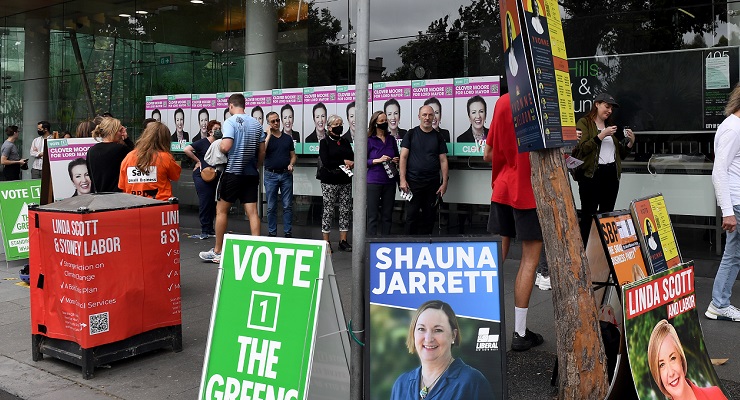
This weekend we started to see how the COVID-triggered close of Sydney’s community newspapers is damaging democracy at its most local level, with a significant fall in an informed, engaged vote in New South Wales’ local council elections.
In April last year, News Corp axed more than 100 community and regional newspapers, including most of those that were once dropped free on to suburban lawns every week. They now exist — if at all — as “local” pages within the site of the company’s pay-walled city tabloid.
There’s more “local” in the brand than in the news. The “Parramatta” page in Sydney’s Tele reported this weekend’s local council results with a photo of Clover Moore from the City of Sydney, some 25 kilometres to the east.
Saturday was the state’s first run at an election since most of NSW lost its local news. Although the results are still being counted, there are already a few worrying trends for local democracy. Looks like voter turnout is down, informal votes are up, and candidates with an identifiable national brand (Labor, Liberal, Green) have done better than those without (unless, like Moore, they’ve built their own public brand).
The NSW Electoral Commission can take some of the blame, with an ill-thought-through COVID ban on distributing how-to-vote cards at booths and overly complex on-ballot instructions driving informal votes up to one in four in some booths.
Without community or regional newspapers, it’s been difficult for campaigns to get traction, compounded by the long-term snubbing of local councils (and suburban life generally) by an increasingly nationally focused media.
The free suburban model which operated across all capital cities filled the gap in the old ecosystem — nice little earners with heavy advertising support from real estate and classifieds, linked into chains of local monopolies owned by News Corp and Fairfax.
They were stronger on advertising and local boosterism than journalism, but they were the key to finding out what was happening in your community: reporting council meetings, listing developments, providing commentary from councillors and candidates (and usually a paid-for column from the mayor). They made a difference to how a community thought about itself.
It’s no accident that the home of the city’s strongest non-party independents (and now of Zali Steggall) has long been Manly and the northern beaches with the country’s only suburban-based daily paper, the Manly Daily (also closed by News Corp last year).
News Corp’s chain grew out of Rupert Murdoch’s then biggest buy, the Parramatta-based Cumberland Newspapers, for £1 million in 1960, giving him 24 papers across Sydney. The counterweight (now owned by Australian Community Media) grew out of Suburban Publications, a network of the local papers owned by Sydney’s media families — the Packers and the Fairfaxes — to fight the disruptive interloper from Adelaide.
The Sydney chains turned national with the Murdoch takeover of the Herald & Weekly Times in 1987. The Melbourne-based HWT had bought out Packer’s Sydney community papers a year earlier, and with the local papers HWT already owned in Melbourne, Brisbane, Adelaide and Perth, the takeover left News Corp dominating the local scene. Fairfax was left with its own smaller networks in Sydney and Melbourne.
From a local democracy perspective it wasn’t ideal. These were run as money-makers, not political shakers — so much money they regularly attracted start-up competitors, particularly in the real estate-rich inner cities of Sydney and Melbourne.
Suburban local government was below the gaze of the media conglomerates: in the 1970s “Botany affair”, when News needed help with a zoning decision for land it owned in the Labor-controlled Botany council, it went to the top, raising the matter with then state opposition leader Neville Wran.
The residual independent-owned newspapers were often more engaged in local politics, like The Weekly Times in the Bennelong electorate. Even as prime minister, John Howard knew to nurture his local paper.
Some digital players are emerging to fill the gap in Sydney’s suburbs, such as In The Cove, with its reporting this week on campaigning dirty tricks. (Maybe no connection, but early figures suggest a more engaged vote in Lane Cove.)
In others suburbs, it’s left to social media to fill the gap — poorly. Community Facebook groups are either astroturfed for some local interest or more focused on fights over dog poo than engaging local politics.








What about the Bereavements section, now we can only hear of the death of friends or acquaintances by word of mouth or the “bush telegraph.
Growing up on Sydney’s northern beaches and ultimately buying my first house in Manly, the Manly Daily was always our local paper. When I moved to the nsw northern rivers area it was the Byron News and The Echo. One very orthodox right wing, the other more balanced, progressive and always ready to take up to the usually right wing local council. After Murdoch’s take over and ultimate destruction of thousands of local papers, thankfully our Echo is left standing, both in print and online. Over the last few months and weeks there’s been excellent coverage of the local election candidates.
Yep, nothing like the local press to attend council meetings, having worked on a number of Community Newspapers in Perth. A very sad loss, however a big shout out to the Post Group, who prove local newspapers still have a vibrant future.
Having also been a reporter on a local paper back in the day when Murdoch started buying them up and creating Leader Suburbans, I totally agree. It’s heartbreaking to see these small but vital media outlets ripped out of communities. Although most of them have been pale imitations of what they used to be when real estate advertising supported them. However I do think there is an opening there for someone with money who doesn’t mind losing it to set up a local newspaper network for rural and remote communities.